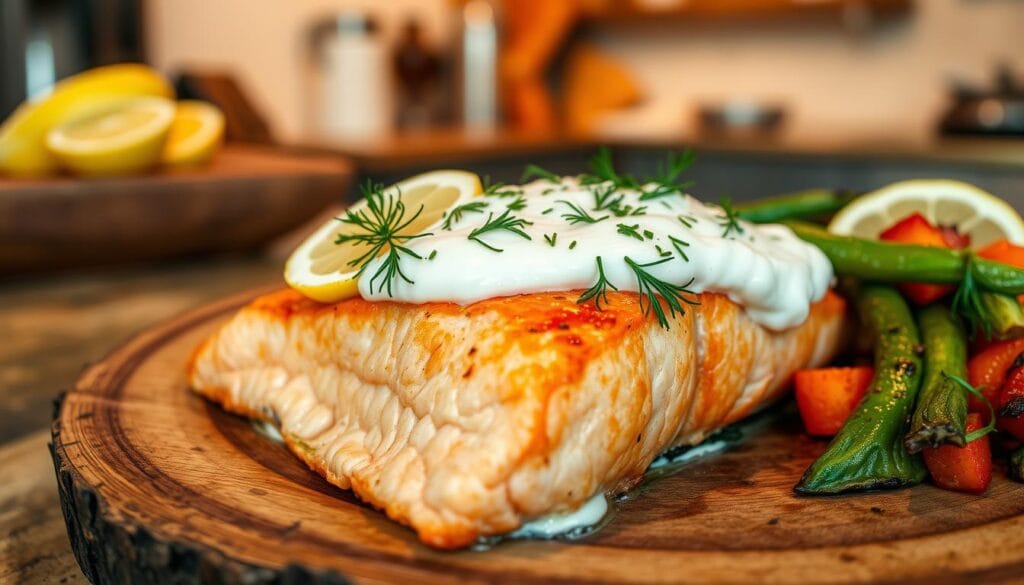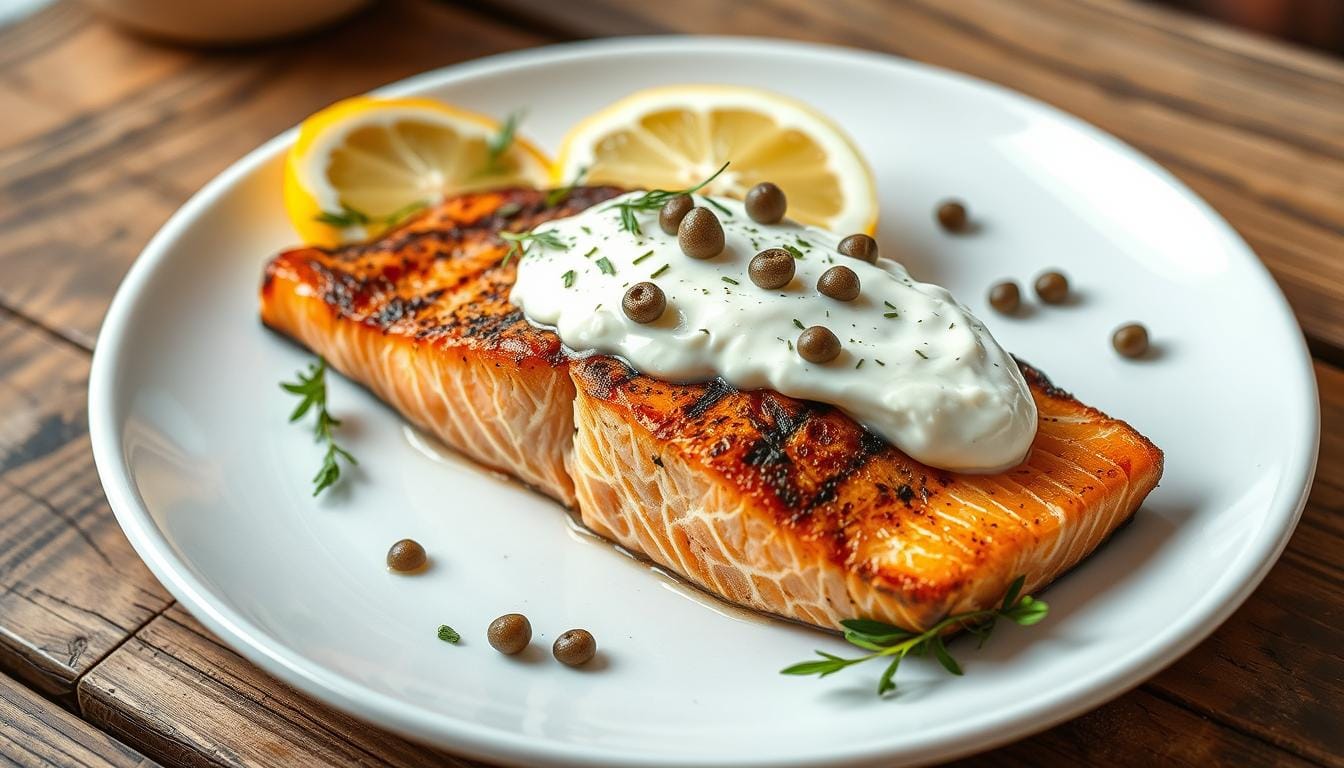Cream Cheese Salmon Recipe: Quick & Easy Dinner
As a busy mom, finding quick and healthy meals is a must. That’s why I’m thrilled to share this amazing cream cheese salmon recipe. It’s a mix of tender salmon and a creamy filling that’s both tasty and filling.
Table of Contents
Key Takeaways
- Creamy, cheesy salmon fillets ready in under 30 minutes
- Protein-rich meal with omega-3 fatty acids from the salmon
- Easy to prepare, making it perfect for busy weeknights
- Versatile dish that can be customized with your favorite herbs and seasonings
- Leftovers can be stored for up to a day, making it a great meal prep option
What You Need to Make Cream Cheese Salmon
To make a tasty cream cheese salmon dish, you’ll need some key ingredients and tools. Start with center-cut salmon fillets for easy stuffing. Then, mix softened cream cheese with fresh baby spinach, garlic, and parmesan and mozzarella cheeses. Don’t forget to add herbs and spices to boost the flavors.
Essential Ingredients for the Recipe
- Salmon fillets (center-cut for easier stuffing)
- Cream cheese, softened to room temperature
- Fresh baby spinach
- Garlic, minced
- Parmesan cheese, grated
- Mozzarella cheese, shredded
- Seasonings (such as dill, lemon, black pepper, and crushed red pepper)
Kitchen Tools Required
- Rimmed baking sheet or casserole dish
- Parchment paper or non-stick cooking spray
- Skillet for sautéing spinach
- Mixing bowls for preparing the cream cheese mixture
With these ingredients and tools, you’re ready to make a delicious salmon cream cheese bagel or other salmon dishes. Make sure the salmon is fresh and the cream cheese is soft for the best taste.
“The key to a perfectly cooked salmon fillet is to not overthink it. Stick to a few high-quality ingredients and let the natural flavors shine.”
Steps to Prepare Cream Cheese Salmon
Make your dinner special with this tasty cream cheese salmon recipe. It’s easy to turn simple salmon fillets into a delicious dish. Follow these steps to create a dish that will delight your taste buds!
Preparing the Salmon Fillet
Begin by rinsing the salmon fillets under cold water. Then, pat them dry with a paper towel. Use a sharp knife to make a pocket in the center of each fillet. This pocket is where the creamy filling will go.
Making the Cream Cheese Mixture
In a pan, cook some fresh spinach with garlic and seasoning. Let it cool a bit, then mix it with softened cream cheese, mozzarella, and Parmesan. This creamy mix will be the highlight of your cream cheese salmon dip.
Preheat your oven to 425°F (218°C). Fill the salmon pockets with the cream cheese mix. Drizzle olive oil and season with salt and pepper on top.
Now, your salmon is ready to bake. Get ready to wow your family and friends with this amazing cream cheese salmon dish!
Flavor Enhancements for Your Dish
Make your cream cheese salmon even better with herbs, seasonings, and add-ins. These simple touches can turn your dish into a feast for the senses.
Herbs and Seasonings to Consider
Begin with fresh herbs like parsley, basil, or dill. They bring a fresh taste to your salmon. Try dried seasonings like paprika, Italian seasoning, or red pepper flakes for depth and warmth.
Optional Add-Ins for Extra Flavor
- Sun-dried tomatoes: Add a sweet and tangy taste.
- Capers: Bring a salty, sharp flavor.
- Finely chopped bell peppers: Add crunch and sweetness.
- Lemon juice or zest: Add a zesty citrus touch.
Don’t be afraid to mix and match herbs, seasonings, and add-ins. Start small and adjust to taste. This way, you can find the perfect flavor for your cream cheese salmon.
“Flavor is the essence of a dish, and with a few strategic additions, you can transform a simple salmon recipe into a culinary masterpiece.” – Gordon Ramsay, renowned chef and restaurateur
| Ingredient | Quantity |
|---|---|
| Salmon fillets | 4 (6 ounces each) |
| Puff pastry sheets | 1 |
| Oven temperature | 400°F (200°C) |
| Baking time | 20-25 minutes |
| Internal temperature goal for salmon | 145°F (63°C) |
Cooking Methods for Cream Cheese Salmon
There are several ways to cook cream cheese salmon, each with its own charm. You can bake it for a classic taste or grill it for a smoky twist. Both methods promise a dish that will make you want more.
Baking the Salmon
Start by preheating your oven to 425°F (218°C). Place the salmon fillets, skin-side down, on a greased baking sheet. Spread the creamy cheese mixture evenly over the salmon. Bake for 8 to 10 minutes until the salmon is flaky and the cheese is bubbly.
This method gives you a crispy outside and a juicy inside. It’s a treat for your taste buds.
Grilling Options for Smoky Flavor
Grilling adds a smoky flavor to your salmon. Heat your grill to medium-high. Oil the grates to prevent sticking. Place the salmon fillets, cheese-side up, on the grill.
Cook for 4 to 5 minutes on each side. Use a fish spatula to flip the salmon gently. The high heat creates a caramelized crust and a melted cheese sauce.

Both baking and grilling produce amazing results. They let the cream cheese melt and blend with the salmon’s natural flavors. Choose your method, and you’ll get a delicious cream cheese salmon dish that everyone will love.
Serving Suggestions for Cream Cheese Salmon
Make your cream cheese salmon dish even better with these serving suggestions. Pair it with side dishes that match its rich flavors and creamy texture. Roasted veggies like asparagus, Brussels sprouts, or potatoes are great choices. A fresh salad with a light dressing also works well.
Ideal Side Dishes to Pair With
- Fluffy white rice or quinoa
- Roasted broccoli or cauliflower
- Steamed green beans or snap peas
- A refreshing cucumber and tomato salad
Presentation Tips for a Stunning Meal
Enhance your cream cheese salmon’s look with these presentation tips. Add fresh lemon wedges and herbs like dill or parsley for a bright touch. Serve it on warm plates for a fancy feel. Pair it with a crisp white wine like Sauvignon Blanc or Chardonnay for the best taste.
For a stunning display, place the salmon in the center of a platter. Surround it with salmon canapés, like cucumber rounds with the salmon mixture. This makes a beautiful and tasty appetizer or side dish that will wow your guests.
Using these food presentation tips will make your cream cheese salmon dish stand out. It will create a memorable meal that highlights the dish’s flavors and beauty.
Nutritional Benefits of Salmon and Cream Cheese
Salmon is a nutritional powerhouse, packed with omega-3 fatty acids, high-quality protein, and essential vitamins and minerals. Adding this flavorful fish to your diet offers many health benefits. Cream cheese, on the other hand, adds a creamy texture and nutritional value to this dish.
Health Advantages of Salmon
Salmon is famous for its omega-3 fatty acids, which are key for heart health and brain function. These healthy fats help reduce inflammation, lower triglycerides, and improve blood vessel function. Salmon also provides 18.3 grams of protein per 100-gram serving, making it a filling meal.
Salmon is rich in vitamins and minerals like vitamin B12, vitamin D, selenium, and potassium. These nutrients boost the immune system, support strong bones, and overall well-being. Eating salmon regularly may lower the risk of heart disease and certain types of cancer.
Benefits of Incorporating Cream Cheese
While cream cheese is calorie-dense, it can be part of a balanced diet in moderation. It provides calcium and vitamin A, important for bone health and immune function. The creamy texture it adds makes the dish more satisfying and enjoyable.
By mixing salmon and cream cheese, you get a meal that’s not only tasty but also full of nutrients. This supports your overall health and well-being.

Tips for Perfectly Cooked Salmon
Cooking salmon to perfection is a great goal. With a few easy tips, you can improve your how to cook salmon skills. Whether baking, grilling, or pan-searing, focus on doneness and avoid common errors. This will help you make a delicious salmon dish.
Checking for Doneness
Watch your salmon closely while it cooks. Use a fork to check the thickest part of the salmon. It should flake easily. An internal temperature of 145°F is perfect for doneness.
Common Mistakes to Avoid
- Overcooking: Avoiding overcooked salmon is key. Overcooked salmon gets dry and tough. So, take it off the heat when it’s just right.
- Removing the Skin: Don’t remove the skin before cooking. The skin keeps the salmon together and prevents it from breaking apart.
- Lack of Temperature Equilibrium: Let your salmon fillets come to room temperature before cooking. This ensures even cooking and doneness.
By following these tips and avoiding common mistakes, you’ll cook salmon perfectly every time. This is great for your cream cheese salmon recipe or any seafood dish.
Variations on the Classic Cream Cheese Salmon Recipe
Try new things with your cream cheese salmon dish. You can use different cream cheeses and proteins. This way, you can make your dish unique and tasty.
Different Cream Cheese Flavors to Try
Don’t just stick to plain cream cheese. Try herb and garlic cream cheese for a savory taste. Or, use smoked salmon-infused cream cheese for a smoky flavor.
Goat cheese or brie can add a luxurious touch. They make your dish creamy and rich.
Alternative Proteins for a Twist
- Use chicken breast for a leaner option. The cream cheese pairs well with chicken.
- Try white fish like cod or halibut. The cream cheese makes it moist and creamy.
- Use shrimp or scallops for a seafood twist. It’s a tasty and versatile dish.
Be creative and have fun with your variations. Try new flavors and find what you like best.
Storing and Reheating Cream Cheese Salmon
To keep your leftover cream cheese salmon tasty, it’s important to store and reheat it right. A few simple steps can make your dish last for days.
Best Practices for Storage
Store cooked cream cheese salmon in an airtight container in the fridge for 3-4 days. Cool it down to room temperature first. For longer storage, freeze it for up to 3 months. Thaw it in the fridge for 6 hours before reheating.
How to Reheat Without Drying Out
Reheating in the oven is best to avoid drying out the salmon. Place it on a baking sheet, cover with foil, and warm at 350°F (175°C) for 10-15 minutes. It should reach 145°F (63°C) inside. Don’t use the microwave, as it can dry out the salmon fast. Or, gently reheat it in a skillet with a bit of olive oil or water, but don’t overcook it.

